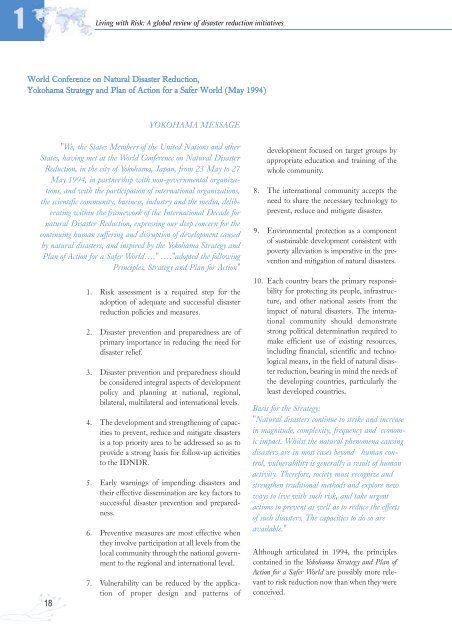A global review of disaster reduction initiatives - Welcome to the ...
A global review of disaster reduction initiatives - Welcome to the ...
A global review of disaster reduction initiatives - Welcome to the ...
Create successful ePaper yourself
Turn your PDF publications into a flip-book with our unique Google optimized e-Paper software.
1Living with Risk: A <strong>global</strong> <strong>review</strong> <strong>of</strong> <strong>disaster</strong> <strong>reduction</strong> <strong>initiatives</strong>World Conference on Natural Disaster Reduction,Yokohama Strategy and Plan <strong>of</strong> Action for a Safer World (May 1994)YOKOHAMA MESSAGE"We, <strong>the</strong> States Members <strong>of</strong> <strong>the</strong> United Nations and o<strong>the</strong>rStates, having met at <strong>the</strong> World Conference on Natural DisasterReduction, in <strong>the</strong> city <strong>of</strong> Yokohama, Japan, from 23 May <strong>to</strong> 27May 1994, in partnership with non-governmental organizations,and with <strong>the</strong> participation <strong>of</strong> international organizations,<strong>the</strong> scientific community, business, industry and <strong>the</strong> media, deliberatingwithin <strong>the</strong> framework <strong>of</strong> <strong>the</strong> International Decade fornatural Disaster Reduction, expressing our deep concern for <strong>the</strong>continuing human suffering and disruption <strong>of</strong> development causedby natural <strong>disaster</strong>s, and inspired by <strong>the</strong> Yokohama Strategy andPlan <strong>of</strong> Action for a Safer World…." …."adopted <strong>the</strong> followingPrinciples, Strategy and Plan for Action"181. Risk assessment is a required step for <strong>the</strong>adoption <strong>of</strong> adequate and successful <strong>disaster</strong><strong>reduction</strong> policies and measures.2. Disaster prevention and preparedness are <strong>of</strong>primary importance in reducing <strong>the</strong> need for<strong>disaster</strong> relief.3. Disaster prevention and preparedness shouldbe considered integral aspects <strong>of</strong> developmentpolicy and planning at national, regional,bilateral, multilateral and international levels.4. The development and streng<strong>the</strong>ning <strong>of</strong> capacities<strong>to</strong> prevent, reduce and mitigate <strong>disaster</strong>sis a <strong>to</strong>p priority area <strong>to</strong> be addressed so as <strong>to</strong>provide a strong basis for follow-up activities<strong>to</strong> <strong>the</strong> IDNDR.5. Early warnings <strong>of</strong> impending <strong>disaster</strong>s and<strong>the</strong>ir effective dissemination are key fac<strong>to</strong>rs <strong>to</strong>successful <strong>disaster</strong> prevention and preparedness.6. Preventive measures are most effective when<strong>the</strong>y involve participation at all levels from <strong>the</strong>local community through <strong>the</strong> national government<strong>to</strong> <strong>the</strong> regional and international level.7. Vulnerability can be reduced by <strong>the</strong> application<strong>of</strong> proper design and patterns <strong>of</strong>development focused on target groups byappropriate education and training <strong>of</strong> <strong>the</strong>whole community.8. The international community accepts <strong>the</strong>need <strong>to</strong> share <strong>the</strong> necessary technology <strong>to</strong>prevent, reduce and mitigate <strong>disaster</strong>.9. Environmental protection as a component<strong>of</strong> sustainable development consistent withpoverty alleviation is imperative in <strong>the</strong> preventionand mitigation <strong>of</strong> natural <strong>disaster</strong>s.10. Each country bears <strong>the</strong> primary responsibilityfor protecting its people, infrastructure,and o<strong>the</strong>r national assets from <strong>the</strong>impact <strong>of</strong> natural <strong>disaster</strong>s. The internationalcommunity should demonstratestrong political determination required <strong>to</strong>make efficient use <strong>of</strong> existing resources,including financial, scientific and technologicalmeans, in <strong>the</strong> field <strong>of</strong> natural <strong>disaster</strong><strong>reduction</strong>, bearing in mind <strong>the</strong> needs <strong>of</strong><strong>the</strong> developing countries, particularly <strong>the</strong>least developed countries.Basis for <strong>the</strong> Strategy:"Natural <strong>disaster</strong>s continue <strong>to</strong> strike and increasein magnitude, complexity, frequency and economicimpact. Whilst <strong>the</strong> natural phenomena causing<strong>disaster</strong>s are in most cases beyond human control,vulnerability is generally a result <strong>of</strong> humanactivity. Therefore, society must recognize andstreng<strong>the</strong>n traditional methods and explore newways <strong>to</strong> live with such risk, and take urgentactions <strong>to</strong> prevent as well as <strong>to</strong> reduce <strong>the</strong> effects<strong>of</strong> such <strong>disaster</strong>s. The capacities <strong>to</strong> do so areavailable."Although articulated in 1994, <strong>the</strong> principlescontained in <strong>the</strong> Yokohama Strategy and Plan <strong>of</strong>Action for a Safer World are possibly more relevant<strong>to</strong> risk <strong>reduction</strong> now than when <strong>the</strong>y wereconceived.

















